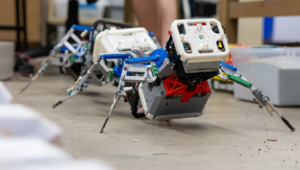Four- and two-legged robots need a lot of expensive sensors and complex algorithms to navigate difficult terrain. The researchers now approached the problem in a simpler way and added many pairs of legs to the worm-like machine, which allows the robot to overcome taxis without the help of sensors.
The Georgia Institute of Technology team, led by Dr. Baxi Chong, designed the robot for situations where sensors may be too fragile or environmental conditions may change too quickly for control systems to adapt.
Scientists were inspired by the communication theory developed by mathematician Claude Shannon in 1948, which suggested, among other things, that in order to transmit a message over a long distance over a noisy line, the message should be broken up into repeating units.
In the case of the robot, these units were legs. The researchers started with a six-legged robot that had to navigate a path on an uneven surface that mimicked a chaotic natural environment. After each trial, the researchers added an extra pair of legs until the robot finally had 16 legs in total.
It was found that with more legs, the robot got progressively better at overcoming obstacles. Importantly, the robot did this without using sensors or adaptive programming. Instead, the robot simply relied on the fact that if one or even a couple of legs were to slip, there would still be plenty of others to keep the robot moving.
It is also clear that at some point the costs of multiple feet will outweigh the benefits. Researchers have yet to determine where that sweet spot lies, as different robots perform tasks in different environments.
Source: New Atlas

